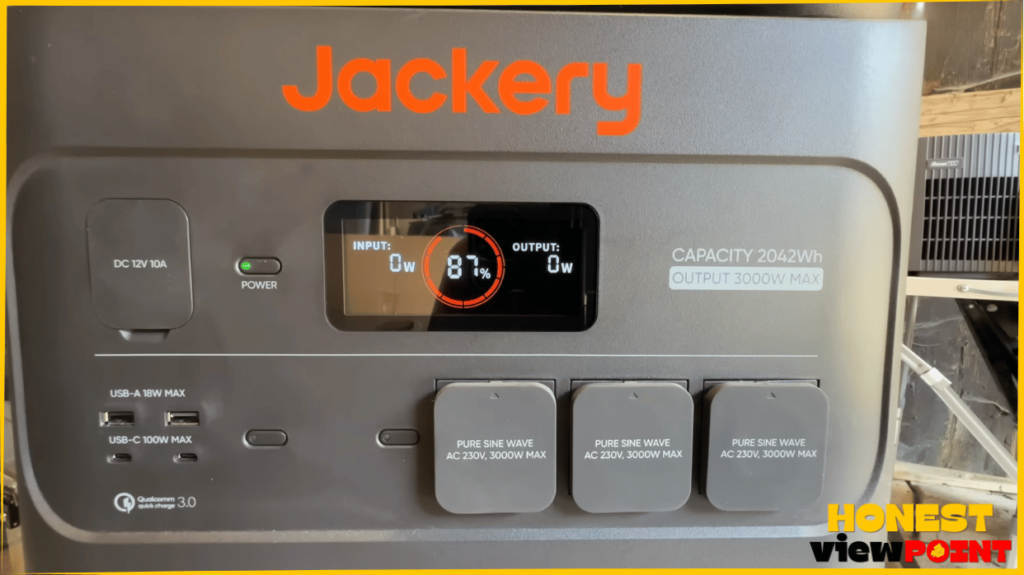Hey there, fellow adventurers! My name is Jerry and today, I’m diving headfirst into the realm of portable power with the Jackery Explorer 2000 Plus. Whether I’m camping lakeside or hitting the open road in my trusty camper van, having reliable electricity at my fingertips is an absolute game-changer. Join me as I take a deep dive into the features and capabilities of this powerhouse portable power station, from its impressive wattage output to its seamless compatibility with solar panels. Together, let’s uncover whether the Explorer 2000 Plus truly lives up to the hype and keeps me charged on all my thrilling adventures!
Jackery Explorer 2000 Plus
Your Ultimate Power Solution for Camping and Vanlife
Experience the ultimate in portable power with the Jackery Explorer 2000 Plus. This powerful and durable power station offers a robust 3000-watt inverter and a versatile array of AC, USB-A, and USB-C ports to keep all your devices charged. It even supports expansion with additional battery packs for an impressive 12 kilowatt-hours of capacity. With convenient wheels and handles for easy transport, it’s perfect for off-grid adventures, camping, and vanlife.
Unboxing and Initial Impressions

From the moment the delivery truck arrived, my excitement was through the roof. I eagerly awaited my long-anticipated order. To my surprise, the delivery included not just one, but two crates! I knew I’d ordered a power station and an aditional battery pack, but seeing two crates on my doorstep made me even more curious and excited.
After quickly tearing them open, I discovered the Jackery Explorer 2000 Plus in one crate and the additional battery pack in the other—they both arrived on the same day! The idea that I could connect up to five of these battery packs to the main unit was thrilling, promising a massive 12 kilowatt-hours of battery capacity!
Power and Ports
Upon closer inspection of the features, I was delighted to find that the Explorer 2000 Plus boasts the same formidable 3000-watt inverter power as the Jackery 3000 Pro, coupled with the added benefit of a new lithium-ion battery type. This means serious power output with the ability to effortlessly handle peak loads of up to 6000 watts. And let’s not overlook the plethora of ports – USB, 12-volt, and more – perfect for satisfying all your charging needs.
Accessories and Design

In terms of accessories, Jackery has left no stone unturned, providing everything you need, from a convenient car charger to a reliable power cable for charging at home. Plus, they’ve even thoughtfully included adapters for seamlessly connecting older solar panels to the unit. However, I did notice a minor hiccup – the absence of an instruction manual in the package. Nevertheless, this was swiftly remedied with a digital copy, covering all the essentials I needed to know.
Now, let’s delve into the design. Weighing in at approximately 28 kilograms, the Explorer 2000 Plus certainly packs a punch in terms of weight. However, fear not, as it comes equipped with sturdy handles and wheels for effortless transport. Though, if I were to nitpick, I’d suggest slightly larger wheels for smoother maneuverability on rugged terrain.
As for the battery pack, it weighs about 19 kilograms – still substantial, but manageable thanks to its well-designed deep handles for comfortable carrying.
Functionality and Usability

Overall, my initial impressions are overwhelmingly positive. The Jackery Explorer 2000 Plus exudes the aura of a true powerhouse portable power station, and I’m eager to put it through its paces in the days to come.
Now, let’s dive into the nitty-gritty and explore the various functions step by step. Commencing with the main power switch, a single press brings the Jackery Explorer 2000 Plus to life, illuminating the display with the current battery charge status. You’ll notice a circular indicator representing the battery level, alongside input and output ports for seamless power flow.
Transitioning to the USB section, we’re greeted with two standard USB-A ports, perfect for charging smartphones or tablets, and two USB-C ports, ideal for powering laptops. Activating this section is a breeze – simply enable the DC output, which also powers the 12-volt socket for car accessories or camping gear.
Inverter and Connectivity
Now, let’s journey into the inverter, the heart and soul of this solar generator. Equipped with three AC outlets, it delivers a total power output of 3000 watts, providing genuine sine wave AC power akin to household outlets.
On the rear panel, you’ll find the standard power input socket, accompanied by two DC inputs for solar panels or the car cigarette lighter adapter. Additionally, there’s an easily accessible input reset for added safety. Notably, the 2000 Plus model features a specialized connector for the expansion battery pack, allowing for a significant increase in overall battery capacity.
Jackery Expansion Battery Pack 2000 Plus
Expand Your Power Capacity On the Go
Take your portable power to the next level with the Jackery Expansion Battery Pack 2000 Plus. Designed to work seamlessly with the Jackery Explorer 2000 Plus, this additional battery pack allows you to double your power capacity, giving you up to 12 kilowatt-hours when fully expanded. It’s the ideal solution for extended camping trips, vanlife, and other off-grid adventures. With deep handles for easy carrying, it’s ready to go wherever you need extra power.
Battery Management

Speaking of the expansion battery pack, it boasts a capacity indicator and a power switch. Once seamlessly connected, it’s remotely controlled by the main Explorer 2000 Plus unit. However, it’s crucial to note that the capacity indicator solely reflects the main unit’s battery level, not the total capacity when additional packs are attached.
Overall, these devices operate in harmony, with just a slight 3-5% variance in battery levels. Keeping tabs on individual pack capacities ensures precise power management and unwavering reliability.
Real-world Testing and Efficiency

Now, let’s roll up our sleeves and dive into some real-world testing. One standout feature of the Explorer 2000 Plus is its adeptness at intelligently managing both discharging and recharging to maintain a harmonious power distribution. Allow me to share a relatable analogy to elucidate this concept further.
Imagine your morning coffee routine. Picture yourself with both a large coffee mug and a smaller thermos. When you pour your coffee in the morning, you initially fill up your large mug. As you gradually sip from it, the coffee level in the mug diminishes until it’s nearly empty. At that point, you switch to sipping from your thermos until both vessels are at an equal level again. This mirrors how the Explorer 2000 Plus operates.
During my testing, I observed that when recharging, the additional battery pack is first toped up until it reaches parity with the main unit. Once equilibrium is achieved, the main unit initiates charging. Similarly, during usage, power is primarily drawn from the main unit until it reaches a certain threshold, at which point it seamlessly transitions to drawing from the additional pack to uphold balance.
Battery Lifespan and Charging Options

This intelligent management ensures a steady and efficient utilization of power, akin to how you meticulously manage your coffee consumption between two distinct vessels to maintain optimal caffeine levels throughout the morning.
Now, let’s pivot to the pivotal enhancement of the Explorer 2000 Plus compared to its Pro model counterpart – the battery. The newer model boasts a different battery type, offering double the lifespan of the Pro model, with an impressive 4000 cycles. Despite featuring one-third less capacity (2000 watt-hours compared to 3000 watt-hours), the new battery offers unparalleled durability benefits. Moreover, the option to further expand capacity with additional battery packs adds an unparalleled level of versatility.
Concerning charging methods, users are presented with three viable options: mains power, solar panels, or DC 12-volt input (e.g., car cigarette lighter). The swiftest method remains through mains power. During a time-lapse test, we witnessed a remarkable 80% charge within just one hour, with a complete charge attainable in slightly over one and a half hours. These results were achieved solely with the Explorer 2000 Plus, sans additional battery packs.
MPPT Solar Charge Controller

A standout feature of the Explorer 2000 Plus is its formidable MPPT solar charge controller, akin to its predecessor, the 2000 Pro. This component plays a pivotal role in utilizing the power station as a solar generator. Let’s delve into some practical tests with solar panels.
Initially, I put the SolarSaga 100, Jackery’s smallest panel, to the test. Following a swift adaptation of the conector, I achieved an impressive 95 watts output. However, to fully replenish the power station from empty, it would necessitate approximately 20 to 25 hours with this modest panel alone.
Solar Panel Integration
To expedite the process, I connected two SolarSaga 200 panels, each yielding nearly 200 watts. This boosted my total output to 371 watts, a substantial improvement. Introducing a third panel elevated it to 553 watts, and with a fourth, I reached approximately 620 watts. While undeniably impressive, I observed a marginal decrease in efficiency with the fourth panel due to the power being split between inputs.
Jackery SolarSaga 200W Portable Solar Panel
Charge Anywhere, Anytime with Solar Power
Harness the sun’s energy with the Jackery SolarSaga 200W Portable Solar Panel. This high-efficiency solar panel is the perfect companion for your Jackery power station, delivering nearly 200 watts of clean energy to keep you charged on the go. It’s lightweight and easy to set up, making it ideal for camping, vanlife, and off-grid living. Plus, with the ability to connect multiple SolarSaga panels, you can create a solar array to speed up your recharging times.
Versatility and Adaptability
However, the possibilities extend beyond these confines. With the Explorer 2000 Plus, I could potentially integrate up to 1400 watts of solar panels. This presents an avenue for expedited recharging times, particularly if I’m solely reliant on solar power.
Furthermore, I conducted tests with alternative solar panels from diverse manufacturers, such as Plugin Festival’s offerings. Coupled with suitable adapters, these panels delivered varying levels of power output, further enriching the charging options for the Explorer 2000 Plus.





